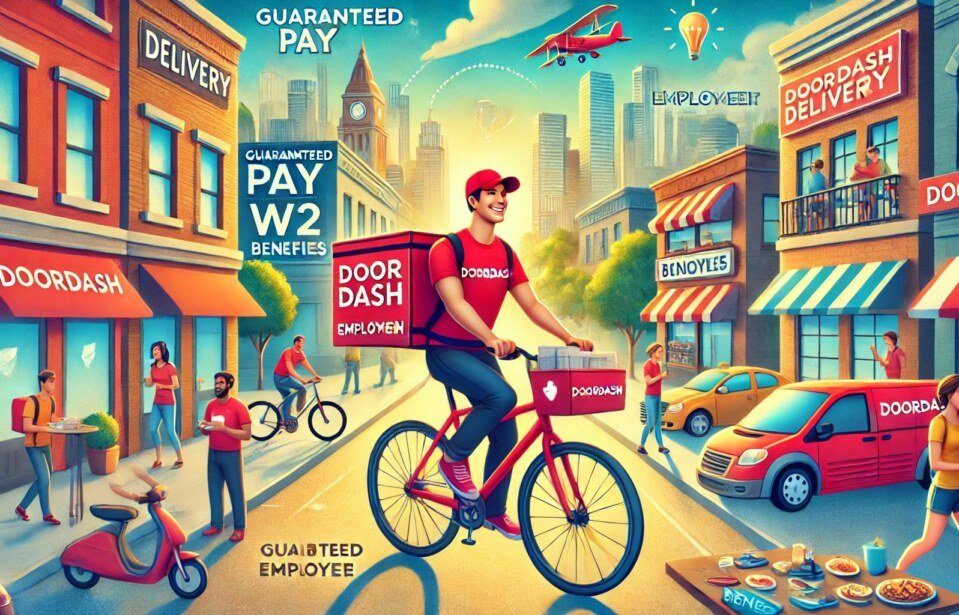The gig economy has long relied on independent contractors, but now DoorDash is piloting a W2 employee-based delivery model in select markets. This shift marks a significant departure from the platform’s traditional 1099 contractor model. What does this mean for drivers, customers, and the broader delivery service industry? In this article, we’ll explore DoorDash’s W2 pilot program and its potential implications for all stakeholders.
What is DoorDash’s W2 Employee-Based Delivery Model?
DoorDash’s W2 employee-based delivery model is an initiative where delivery drivers, known as Dashers, are hired as W2 employees rather than independent contractors. Traditionally, DoorDash and other delivery platforms like UberEats and GrubHub have classified their drivers as independent contractors. These contractors operate with flexible hours, choosing when and where to deliver, but they do not receive benefits like health insurance or a guaranteed hourly wage.
In the new model, W2 employees would have set schedules, a guaranteed wage, and access to benefits like healthcare and paid time off. This model more closely aligns with traditional employment structures, which some argue could provide more stability for workers in the gig economy.
Why DoorDash is Shifting from 1099 Contractors to Employees
The move to pilot an employee-based model isn’t entirely unexpected. Across the U.S., there has been growing pressure from legislators and labor advocates to offer gig workers better protections. In states like California, initiatives such as AB5 aimed to reclassify gig workers as employees. While DoorDash and other companies fought these changes, it seems that DoorDash is now experimenting with a hybrid model to balance flexibility with employee benefits.
This shift allows DoorDash to test a model that could potentially comply with changing regulations while improving conditions for its drivers. The DoorDash W2 employee-based delivery model could serve as a blueprint for future operations, should regulatory environments continue to evolve.
How the New Model Will Impact Drivers
For drivers, the DoorDash W2 pilot program introduces several changes, both positive and negative.
Benefits for Drivers:
- Guaranteed Income: Unlike contractors who are paid per delivery, W2 employees will have a guaranteed hourly wage, providing more financial security.
- Benefits: Employee-based drivers may receive health insurance, retirement contributions, and paid time off—benefits that are rare in the gig economy.
- Job Stability: W2 employees will have a more predictable income stream, thanks to their employment status.
Potential Downsides:
- Reduced Flexibility: One of the major attractions of gig work is flexibility. W2 employees may have less control over their schedules and delivery zones.
- Performance Standards: Employees might be subject to stricter performance evaluations, including meeting quotas or maintaining high customer service ratings.
Markets Testing the W2 Pilot Program
Currently, DoorDash has launched the W2 employee-based delivery model in select markets to gauge its viability. These markets include cities with high delivery volumes, where the company can test how the model affects efficiency, customer satisfaction, and profitability.
Some of the cities reportedly participating in the trial are New York City, Chicago, and San Francisco—all of which have seen legal battles over the classification of gig workers. If successful, this pilot program could be expanded to other regions.
Industry Reactions to DoorDash’s W2 Employee Shift
The delivery industry is closely watching DoorDash’s move toward an employee-based delivery system. For years, platforms have argued that maintaining drivers as independent contractors was essential for scalability and flexibility. However, critics have pointed out that this model often leaves drivers without essential benefits and job security.
Proponents of the Shift:
Labor groups have praised the pilot program, noting that it represents progress toward fairer treatment for gig workers. Some drivers, especially those looking for more stable incomes, may find the transition to a W2 employee-based model appealing.
Opponents:
On the other hand, some drivers and industry experts are concerned that this change could remove the flexibility that many workers value. For part-time drivers or those who enjoy setting their own hours, becoming a W2 employee could reduce the attractiveness of the job.
How the W2 Model Could Impact Pay
The DoorDash W2 employee-based delivery model will undoubtedly impact how drivers are paid. Here’s what drivers can expect in terms of pay and compensation:
1. Guaranteed Hourly Wage
- One of the primary benefits of the W2 employee model is that drivers will earn a guaranteed hourly wage, regardless of the number of deliveries completed. This provides more stability, as drivers can count on a consistent income, even during slow hours when there may not be as many orders.
- In contrast, 1099 contractors are paid per delivery, meaning their earnings fluctuate based on demand, tips, and location. With the W2 model, this variability is reduced, as drivers will receive a steady paycheck.
2. Eligible for Overtime Pay
- As W2 employees, drivers may be eligible for overtime pay if they work beyond a standard 40-hour workweek. This could increase overall earnings for full-time drivers, offering them an opportunity to boost their income during high-demand periods.
3. Access to Benefits
- While benefits such as health insurance, paid time off, and retirement contributions don’t directly increase hourly wages, they do provide value that is factored into overall compensation. These benefits can reduce drivers’ out-of-pocket costs for healthcare or retirement savings, improving their long-term financial situation.
- Independent contractors typically have to cover these expenses on their own, which can eat into their earnings.
4. Less Dependence on Tips
- Under the 1099 contractor model, tips from customers make up a large portion of drivers’ earnings. This means income can be unpredictable and vary based on the generosity of customers and the volume of deliveries.
- In the W2 model, tips may still be allowed, but drivers will rely less on tips as a significant part of their income since they’ll be receiving a steady wage. This could make earnings more predictable, although some drivers may find their total income lower if tips aren’t as substantial.
5. Tax Implications
- W2 employees have taxes automatically deducted from their paychecks (Social Security, Medicare, and federal income tax), which simplifies tax management. They also benefit from employer contributions to Social Security and Medicare, which can boost their retirement savings and healthcare security in the future.
- On the other hand, 1099 contractors are responsible for managing their own taxes, including paying self-employment taxes. While contractors can deduct business expenses, this often leads to a more complex tax filing process.
6. Reduction in Flexibility and Earnings Potential
- One potential downside of the W2 model is the reduction in flexibility. W2 employees will have set shifts, and they may not have the ability to work additional hours beyond their assigned schedule. For drivers who thrive on flexibility and like to work during peak times (such as weekends or holidays), this model could limit their earning potential.
- Additionally, high-performing drivers who work long hours or during high-demand periods might see a dip in overall earnings compared to their 1099 counterparts who can maximize peak-hour bonuses and tips.
7. Performance-Based Pay Adjustments
- In some cases, DoorDash may offer performance-based incentives or bonuses to employees who meet delivery quotas or maintain high customer satisfaction ratings. This could help top-performing drivers earn more, though they may still be capped compared to the unlimited potential earnings for 1099 contractors who work more hours.
Will Earnings Increase Under DoorDash’s W2 Employee-Based Model?
Whether or not earnings increase for drivers under DoorDash’s W2 employee-based model depends on several factors, including the volume of deliveries, work schedule, and access to additional incentives or bonuses. Here’s a breakdown of how earnings might change:
1. Guaranteed Wage vs. Performance-Based Earnings
- In the W2 model, drivers are guaranteed a steady hourly wage, which offers more predictable income compared to the fluctuating pay of the 1099 contractor model. For drivers who currently experience slow periods or struggle to get consistent orders, this guaranteed pay could lead to higher overall earnings.
- However, drivers who thrive on completing a high volume of deliveries during peak times or who rely heavily on tips may find their earnings limited. The W2 model sets a cap on how much they can make per hour, which could be less than what some 1099 drivers earn during peak hours or high-demand periods.
2. Earning Stability
- The biggest advantage of the W2 employee model is income stability. Drivers will receive pay regardless of delivery volume, meaning there is less risk of earning too little on a slow day. This is especially beneficial for drivers in areas with fluctuating demand.
- For part-time drivers, or those who prefer flexibility to maximize earnings during busy times, the limited earning potential of the W2 model could mean their overall pay decreases, especially when tips and bonuses are reduced or capped.
3. Overtime and Performance Bonuses
- W2 drivers are eligible for overtime pay if they work beyond a 40-hour week, which could lead to higher earnings for full-time drivers during periods of high demand.
- DoorDash may also offer performance-based incentives or bonuses for drivers who meet certain delivery quotas or maintain high customer satisfaction ratings. While this could boost earnings, these incentives may be capped, limiting the total income compared to the limitless potential of 1099 contractors.
4. Reduction in Tax Responsibilities
- W2 employees benefit from having taxes automatically deducted from their paychecks and employer contributions to Social Security and Medicare. While this doesn’t immediately increase take-home pay, it could save drivers money during tax season, as they won’t be responsible for self-employment taxes.
Conclusion
The DoorDash W2 employee-based delivery model signals a potential shift in the gig economy, moving from independent contractor status to more traditional employment. For drivers, the change means greater job security, access to benefits, and a steady wage. However, it also comes with less flexibility and a potential cap on earnings compared to the 1099 contractor model.
How this pilot program will impact pay, delivery efficiency, and the overall industry is yet to be fully seen. However, it represents a critical moment in the evolution of gig work. The implications for drivers, customers, and the broader industry will become clearer as this pilot program unfolds.





Leave a comment